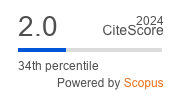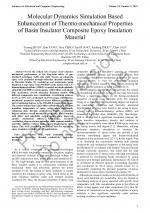| 2/2025 - 1 | View TOC | « Previous Article | Next Article » |
Molecular Dynamics Simulation Based Enhancement of Thermo-mechanical Properties of Basin Insulator Composite Epoxy Insulation MaterialDUAN, Y. |
| Extra paper information in |
| Click to see author's profile in |
| Download PDF |
Author keywords
epoxy resin, basin insulators, thermo-mechanical properties, thermal conductivity, molecular dynamics
References keywords
epoxy(31), molecular(22), dynamics(17), resin(16), properties(15), polymer(14), simulation(11), mechanical(11), cross(8), voltage(7)
Blue keywords are present in both the references section and the paper title.
About this article
Date of Publication: 2025-06-30
Volume 25, Issue 2, Year 2025, On page(s): 3 - 10
ISSN: 1582-7445, e-ISSN: 1844-7600
Digital Object Identifier: 10.4316/AECE.2025.02001
Web of Science Accession Number: 001555002100001
SCOPUS ID: 105009943344
Abstract
Given the critical role of epoxy resin's thermo-mechanical performance in the long-term safety of gas-insulated switchgear (GIS), this study focuses on enhancing epoxy resin properties through molecular dynamics modeling in Materials Studio. By considering real components, using bisphenol A-type epoxy resin (DGEBA) as the matrix with 3,3-diaminodiphenylsulfone (33DDS) or methyl-tetrahydrophthalic anhydride (MeTHPA) curing agents, Al2O3 filler, and phenol (Ph) accelerator, several molecular dynamics models with different components were established. Crosslinking analyses in 0% to 93% were performed via Perl scripts, with thermo-mechanical properties analyzed across different components and crosslinking degrees in the 250-600 K temperature range. The results indicate that Al2O3 fillers effectively raise the glass transition temperature of epoxy resins while significantly enhancing their thermal conductivity. Higher crosslinking degrees enhance overall mechanical properties, while formulas with fillers and anhydride curing agents show improved specific mechanical indices. Additionally, increased crosslinking degrees elevate molecular chain segment mobility, and filler addition reduces mean square displacement curve slopes. This work provides a theoretical base for optimizing epoxy insulation reliability in GIS applications. |
| References | | | Cited By «-- Click to see who has cited this paper |
| [1] Y. Zhao, Y. He, K. Yang, X. Wang, J. Bai, B. Du, "Improving the surface insulating performance of epoxy resin/Al2O3 composite materials by extending chain of liquid epoxy resin with Me-THPA," High Voltage, vol. 5, pp. 472-481, 2020. [CrossRef] [Web of Science Times Cited 30] [SCOPUS Times Cited 38] [2] S. Okabe, G. Ueta, T. Utsumi, J. Nukaga, "Insulation characteristics of GIS insulators under lightning impulse with DC voltage superimposed," IEEE Transactions on Dielectrics and Electrical Insulation, vol. 22, pp. 1-9, 2015. [CrossRef] [Web of Science Times Cited 31] [SCOPUS Times Cited 48] [3] B. Qi, C. Gao, C. Li, J. Xiong, "The influence of surface charge accumulation on flashover voltage of GIS/GIL basin insulator under various voltage stresses," International Journal of Electrical Power & Energy Systems, vol. 105, pp. 514-520, 2019. [CrossRef] [Web of Science Times Cited 60] [SCOPUS Times Cited 81] [4] P. Ren, Q. Li, H. Liu, Y. Li, P. Peng, N. Xue, "Thermal decomposition mechanism of GIS basin insulator and kinetic parameters-based lifetime prediction methodology," Polymers, vol. 13, pp. 653, 2021. [CrossRef] [Web of Science Times Cited 3] [SCOPUS Times Cited 7] [5] J. Li, A. Wang, "Intelligent defect diagnosis of gis basin insulator via multi-source ultrasonic fusion," Nondestructive Testing and Evaluation, pp. 1-13, 2023. [CrossRef] [Web of Science Times Cited 6] [SCOPUS Times Cited 7] [6] N. Andraschek, A. J. Wanner, C. Ebner, G. Riess, "Mica/epoxy-composites in the electrical industry: Applications, composites for insulation, and investigations on failure mechanisms for prospective optimizations," Polymers, vol. 8, pp. 201, 2016. [CrossRef] [Web of Science Times Cited 47] [SCOPUS Times Cited 55] [7] S. Zhang, "Theoretical analysis of electric heating field and insulation accident of high voltage AC basin insulator," Journal of Physics: Conference Series, vol. 1920, pp. 012026, 2021. [CrossRef] [SCOPUS Times Cited 4] [8] H. Pan, G. Sun, T. Zhao, G. Wang, "Thermal properties of epoxy resins crosslinked by an aminated lignin," Polymer Engineering & Science, vol. 55, pp. 924-932, 2015. [CrossRef] [Web of Science Times Cited 36] [SCOPUS Times Cited 37] [9] A. M. Abd-Elnaiem, O. S. Salman, A. Hakamy, S. I. Hussein, "Mechanical characteristics and thermal stability of hybrid epoxy and acrylic polymer coating/nanoclay of various thicknesses," Journal of Inorganic and Organometallic Polymers and Materials, vol. 32, pp. 2094-2102, 2022. [CrossRef] [Web of Science Times Cited 20] [SCOPUS Times Cited 30] [10] T. D. Chang, S. H. Carr, J. O. Brittain, "Studies of epoxy resin systems: Part B: Effect of crosslinking on the physical properties of an epoxy resin," Polymer Engineering & Science, vol. 22, pp. 1213-1220, 1982. [CrossRef] [Web of Science Times Cited 93] [SCOPUS Times Cited 93] [11] J. Moosburger-Will, M. S. M. G. R. Greisel, R. Horny, S. Horn, "Influence of partial cross-linking degree on basic physical properties of RTM6 epoxy resin," Journal of Applied Polymer Science, vol. 129, pp. 4338-4346, 2013. [CrossRef] [Web of Science Times Cited 32] [SCOPUS Times Cited 39] [12] J. L. Tack, D. M. Ford, "Thermodynamic and mechanical properties of epoxy resin DGEBF crosslinked with DETDA by molecular dynamics," Journal of Molecular Graphics and Modelling, vol. 26, pp. 1269-1275, 2008. [CrossRef] [Web of Science Times Cited 98] [SCOPUS Times Cited 115] [13] S. Hassan, T. Yasin, Z. Imran, S. Batool, "Silane based novel crosslinked chitosan/poly (vinyl alcohol) membrane: Structure, characteristic and adsorption behaviour," Journal of Inorganic and Organometallic Polymers and Materials, vol. 26, pp. 208-218, 2016. [CrossRef] [Web of Science Times Cited 12] [SCOPUS Times Cited 15] [14] X. Wan, B. Demir, M. An, T. R. Walsh, N. Yang, "Thermal conductivities and mechanical properties of epoxy resin as a function of the degree of cross-linking," International Journal of Heat and Mass Transfer, vol. 180, pp. 121821, 2021. [CrossRef] [15] L. H. Tam, D. Lau, "A molecular dynamics investigation on the cross-linking and physical properties of epoxy-based materials," RSC Advances, vol. 4, pp. 33074-33081, 2014. [CrossRef] [Web of Science Times Cited 99] [SCOPUS Times Cited 109] [16] Z. Ruan, C. Kan, L. Wang, "Simulation analysis of temperature field of basin insulator," Journal of Electrical Engineering, vol. 14, pp. 41-46, 2019. [CrossRef] [SCOPUS Times Cited 4] [17] J. C. Capricho, B. Fox, N. Hameed, "Multifunctionality in epoxy resins," Polymer Reviews, vol. 60, pp. 1-41, 2020. [CrossRef] [Web of Science Times Cited 325] [SCOPUS Times Cited 345] [18] J. Li, H. H. Aung, B. Du, "Curing regime modulating insulation performance of anhydride-cured epoxy resin: A review," Molecules, vol. 28, pp. 547, 2023. [CrossRef] [Web of Science Times Cited 55] [SCOPUS Times Cited 73] [19] N. A. Bratasyuk, V. V. Zuev, "The study of the curing mechanism, kinetic and mechanical performance of polyurethane/epoxy composites using aliphatic and aromatic amines as curing agents," Thermochimica Acta, vol. 687, pp. 178598, 2020. [CrossRef] [Web of Science Times Cited 25] [SCOPUS Times Cited 25] [20] H. Yu, B. Pi, P. Chen, F. Qin, "Thermal and mechanical properties of crosslinked epoxy based on molecular dynamics," Journal of BeiJing University of Technology, vol. 45, pp. 322-329, 2019. [CrossRef] [21] L. Matejka, J. Lovy, S. Pokorny, K. Bouchal, K. Dusek, "Curing epoxy resins with anhydrides. Model reactions and reaction mechanism," Journal of Polymer Science: Polymer Chemistry Edition, vol. 21, pp. 2873-2885, 1983. [CrossRef] [Web of Science Times Cited 155] [SCOPUS Times Cited 156] [22] S. Shao, J. He, Y. Yu, Q. Duan, S. Liang, Q. Xie, "Molecular dynamics simulation on thermomechanical properties of epoxy resin/anhydride system," Insulating Materials, vol. 53, pp. 38-43, 2020. [CrossRef] [23] T. Okabe, Y. Oya, K. Tanabe, G. Kikugawa, K. Yoshioka, "Molecular dynamics simulation of crosslinked epoxy resins: Curing and mechanical properties," European Polymer Journal, vol. 80, pp. 78-88, 2016. [CrossRef] [Web of Science Times Cited 110] [SCOPUS Times Cited 124] [24] A. Yadav, A. Kumar, P. K. Singh, K. Sharma, "Glass transition temperature of functionalized graphene epoxy composites using molecular dynamics simulation," Integrated Ferroelectrics, vol. 186, pp. 106-114, 2018. [CrossRef] [Web of Science Times Cited 66] [SCOPUS Times Cited 93] [25] S. U. Patil, S. P. Shah, M. Olaya, P. P. Deshpande, M. Maiaru, G. M. Odegard, "Reactive molecular dynamics simulation of epoxy for the full cross-linking process," ACS Applied Polymer Materials, vol. 3, pp. 5788-5797, 2021. [CrossRef] [Web of Science Times Cited 50] [SCOPUS Times Cited 56] [26] V. B. Gupta, L. T. Drzal, C. C. Lee, M. J. Rich, "The temperature-dependence of some mechanical properties of a cured epoxy resin system," Polymer Engineering & Science, vol. 25, pp. 812-823, 1985. [CrossRef] [Web of Science Times Cited 226] [SCOPUS Times Cited 239] [27] Z. Wang, Q. Lv, S. Chen, C. Li, S. Sun, S. Hu, "Glass transition investigations on highly crosslinked epoxy resins by molecular dynamics simulations," Molecular Simulation. , vol. 41, pp. 1515-1527, 2015. [CrossRef] [Web of Science Times Cited 38] [SCOPUS Times Cited 45] [28] J. Fan, A. Anastassiou, C. W. Macosko, E. B. Tadmor, "Molecular dynamics predictions of thermomechanical properties of an epoxy thermosetting polymer," Polymer, vol. 196, pp. 122477, 2020. [CrossRef] [Web of Science Times Cited 66] [SCOPUS Times Cited 69] [29] R. Huo, Z. Zhang, N. Athir, Y. Fan, J. Liu, L. Shi, "Designing high thermal conductivity of cross-linked epoxy resin via molecular dynamics simulations," Physical Chemistry Chemical Physics, vol. 22, pp. 19735-19745, 2020. [CrossRef] [Web of Science Times Cited 32] [SCOPUS Times Cited 32] [30] Z. Han, L. Zhou, X. Ji, X. Huang, Q. Li, T. Zhao, "Molecular dynamics simulation of epoxy resin/carbon nanotube composites in basin insulators," High Voltage Apparatus, vol. 54, pp. 49-55, 2018. [CrossRef] [SCOPUS Times Cited 10] [31] A. Shokuhfar, B. Arab, "The effect of cross linking density on the mechanical properties and structure of the epoxy polymers: molecular dynamics simulation," Journal of molecular modeling, vol. 19, pp. 3719-3731, 2013. [CrossRef] [Web of Science Times Cited 195] [SCOPUS Times Cited 210] [32] F. Jeyranpour, G. Alahyarizadeh, B. Arab, "Comparative investigation of thermal and mechanical properties of cross-linked epoxy polymers with different curing agents by molecular dynamics simulation," Journal of Molecular Graphics and Modelling, vol. 62, pp. 157-164, 2015. [CrossRef] [Web of Science Times Cited 131] [SCOPUS Times Cited 135] [33] D. Xin, Q. Han, "Molecular dynamics study on the tensile deformation of cross-linking epoxy resin," Journal of molecular modeling, vol. 21, pp. 1-6, 2015. [CrossRef] [Web of Science Times Cited 18] [SCOPUS Times Cited 15] [34] L. Guo, S. Ding, S. Yuan, X. Gou, L. Wang, L. Zhou, "Molecular dynamics simulation of thermo-mechanical properties of hexagonal boron nitride/epoxy resin composites, High Voltage Engineering, vol. 48, pp. 1471-1479, 2022. [CrossRef] [SCOPUS Times Cited 8] [35] Q. Lian, H. Chen, Y. Luo, Y. Li, J. Cheng, Y. Liu, "Toughening mechanism based on the physical entanglement of branched epoxy resin in the non-phase-separated inhomogeneous crosslinking network: An experimental and molecular dynamics simulation study," Polymer, vol. 247, pp. 124754, 2022. [CrossRef] [Web of Science Times Cited 42] [SCOPUS Times Cited 43] [36] F. Aghadavoudi, H. Golestanian, Y. Tadi Beni, "Investigating the effects of resin crosslinking ratio on mechanical properties of epoxy-based nanocomposites using molecular dynamics," Polymer Composites, vol. 38, pp. 433-442, 2017. [CrossRef] [Web of Science Times Cited 61] [SCOPUS Times Cited 66] Web of Science® Citations for all references: 2,162 TCR SCOPUS® Citations for all references: 2,426 TCR Web of Science® Average Citations per reference: 58 ACR SCOPUS® Average Citations per reference: 66 ACR TCR = Total Citations for References / ACR = Average Citations per Reference We introduced in 2010 - for the first time in scientific publishing, the term "References Weight", as a quantitative indication of the quality ... Read more Citations for references updated on 2025-11-14 05:52 in 244 seconds. Note1: Web of Science® is a registered trademark of Clarivate Analytics. Note2: SCOPUS® is a registered trademark of Elsevier B.V. Disclaimer: All queries to the respective databases were made by using the DOI record of every reference (where available). Due to technical problems beyond our control, the information is not always accurate. Please use the CrossRef link to visit the respective publisher site. |
Faculty of Electrical Engineering and Computer Science
Stefan cel Mare University of Suceava, Romania
All rights reserved: Advances in Electrical and Computer Engineering is a registered trademark of the Stefan cel Mare University of Suceava. No part of this publication may be reproduced, stored in a retrieval system, photocopied, recorded or archived, without the written permission from the Editor. When authors submit their papers for publication, they agree that the copyright for their article be transferred to the Faculty of Electrical Engineering and Computer Science, Stefan cel Mare University of Suceava, Romania, if and only if the articles are accepted for publication. The copyright covers the exclusive rights to reproduce and distribute the article, including reprints and translations.
Permission for other use: The copyright owner's consent does not extend to copying for general distribution, for promotion, for creating new works, or for resale. Specific written permission must be obtained from the Editor for such copying. Direct linking to files hosted on this website is strictly prohibited.
Disclaimer: Whilst every effort is made by the publishers and editorial board to see that no inaccurate or misleading data, opinions or statements appear in this journal, they wish to make it clear that all information and opinions formulated in the articles, as well as linguistic accuracy, are the sole responsibility of the author.



